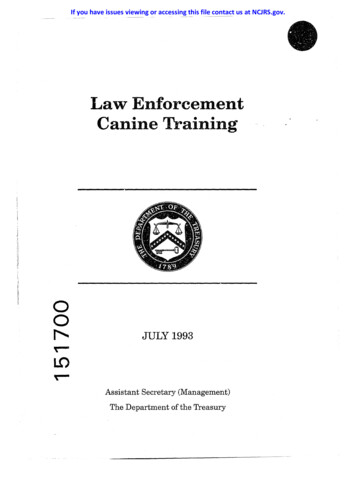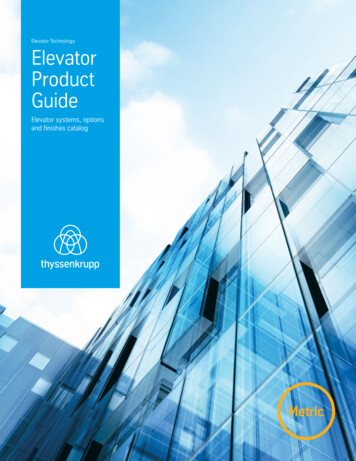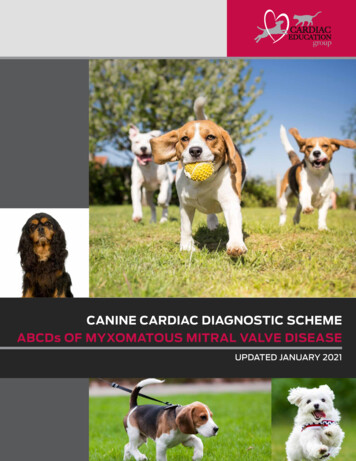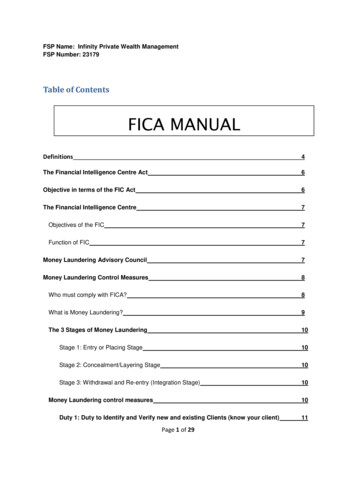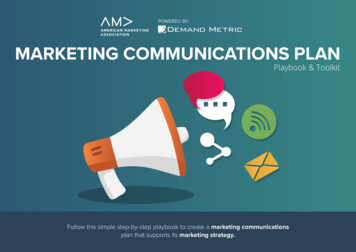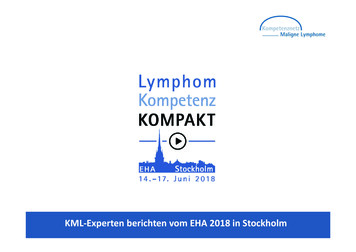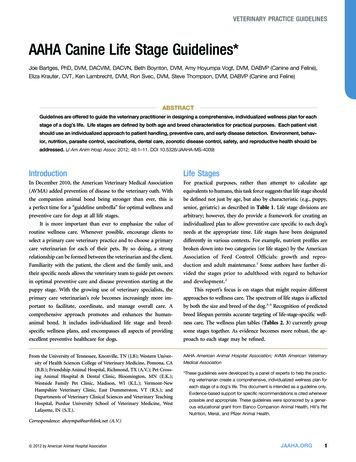
Transcription
VETERINARY PRACTICE GUIDELINESAAHA Canine Life Stage Guidelines*Joe Bartges, PhD, DVM, DACVIM, DACVN, Beth Boynton, DVM, Amy Hoyumpa Vogt, DVM, DABVP (Canine and Feline),Eliza Krauter, CVT, Ken Lambrecht, DVM, Ron Svec, DVM, Steve Thompson, DVM, DABVP (Canine and Feline)ABSTRACTGuidelines are offered to guide the veterinary practitioner in designing a comprehensive, individualized wellness plan for eachstage of a dog’s life. Life stages are defined by both age and breed characteristics for practical purposes. Each patient visitshould use an individualized approach to patient handling, preventive care, and early disease detection. Environment, behavior, nutrition, parasite control, vaccinations, dental care, zoonotic disease control, safety, and reproductive health should beaddressed. (J Am Anim Hosp Assoc 2012; 48:1–11. DOI 10.5326/JAAHA-MS-4009)IntroductionLife StagesIn December 2010, the American Veterinary Medical AssociationFor practical purposes, rather than attempt to calculate age(AVMA) added prevention of disease to the veterinary oath. Withequivalents to humans, this task force suggests that life stage shouldthe companion animal bond being stronger than ever, this isbe defined not just by age, but also by characteristic (e.g., puppy,a perfect time for a “guideline umbrella” for optimal wellness andsenior, geriatric) as described in Table 1. Life stage divisions arepreventive care for dogs at all life stages.arbitrary; however, they do provide a framework for creating anIt is more important than ever to emphasize the value ofindividualized plan to allow preventive care specific to each dog’sroutine wellness care. Whenever possible, encourage clients toneeds at the appropriate time. Life stages have been designatedselect a primary care veterinary practice and to choose a primarydifferently in various contexts. For example, nutrient profiles arecare veterinarian for each of their pets. By so doing, a strongbroken down into two categories (or life stages) by the Americanrelationship can be formed between the veterinarian and the client.Association of Feed Control Officials: growth and repro-Familiarity with the patient, the client and the family unit, andduction and adult maintenance.1 Some authors have further di-their specific needs allows the veterinary team to guide pet ownersvided the stages prior to adulthood with regard to behaviorin optimal preventive care and disease prevention starting at theand development. 2puppy stage. With the growing use of veterinary specialists, theThis report’s focus is on stages that might require differentprimary care veterinarian’s role becomes increasingly more im-approaches to wellness care. The spectrum of life stages is affectedportant to facilitate, coordinate, and manage overall care. Aby both the size and breed of the dog.3–5 Recognition of predictedcomprehensive approach promotes and enhances the human-breed lifespan permits accurate targeting of life-stage-specific well-animal bond. It includes individualized life stage and breed-ness care. The wellness plan tables (Tables 2, 3) currently groupspecific wellness plans, and encompasses all aspects of providingsome stages together. As evidence becomes more robust, the ap-excellent preventive healthcare for dogs.proach to each stage may be refined.From the University of Tennessee, Knoxville, TN (J.B); Western University of Health Sciences College of Veterinary Medicine, Pomona, CA(B.B.); Friendship Animal Hospital, Richmond, TX (A.V.); Pet Crossing Animal Hospital & Dental Clinic, Bloomington, MN (E.K.);Westside Family Pet Clinic, Madison, WI (K.L.); Vermont-NewHampshire Veterinary Clinic, East Dummerston, VT (R.S.); andDepartments of Veterinary Clinical Sciences and Veterinary TeachingHospital, Purdue University School of Veterinary Medicine, WestLafayette, IN (S.T.).AAHA American Animal Hospital Association; AVMA American VeterinaryMedical Association*These guidelines were developed by a panel of experts to help the practicing veterinarian create a comprehensive, individualized wellness plan foreach stage of a dog’s life. This document is intended as a guideline only.Evidence-based support for specific recommendations is cited wheneverpossible and appropriate. These guidelines were sponsored by a generous educational grant from Elanco Companion Animal Health, Hill’s PetNutrition, Merial, and Pfizer Animal Health.Correspondence: ahoympa@earthlink.net (A.V.)ª 2012 by American Animal Hospital AssociationJAAHA.ORG1
Include a veterinary exam and consultation at each of theTABLE 1routine puppy visits as well as prior to the spay/neuter surgery.Proposed Definition of Life StagesProvide a wellness exam and consultation for adult dogs at leastStageDefinitionannually.12 Consider semiannual wellness exams because a dog’sPuppyJuniorNeonate until reproductive maturityReproductively mature, still growinghealth status may change in a short period of time. Pets age fasterAdultFinished growing, structurally and socially matureMatureFrom middle up to approximately the last 25% ofexpected lifespan (a window of time around halflife expectancy for breed)From maturity to life expectancy (approximately thelast 25% of expected lifespan)*SeniorGeriatricthan humans and many medical conditions are not associatedwith clinical signs; therefore, earlier detection of items such asbody weight changes, dental disease, and other concerns allowsfor earlier intervention. In addition, semiannual exams may allowfor more frequent communication with the owner regarding behavior and preventive healthcare. Consider more frequent exam-At life expectancy and beyond*Based on the AAHA Senior Care Guidelines.inations especially for mature, senior, and geriatric dogs.Individualized Approach to theVeterinary Visit(temperature, pulse, respiration, pain, and nutritional assessment)Encourage clients to acclimate dogs to safe travel prior to thescoring system (e.g., body condition score, muscle conditionveterinary visit. Require all clients to restrain dogs on a leash or in ascore).13–18 The exam may also include the following: pain score;carrier upon entering the practice. Arrange the reception entranceheart murmur grade; gait analysis; body mapping for skin masses4Perform a thorough exam including the five vital signsas well as the items listed in Table 2.13 When possible, use a definedto be dog friendly, and to allow clients to minimize encounters withand skin lesions; evaluation for breed-specific risks; and labora-other pets.tory testing and/or imaging as appropriate for breed, age, andPlan appointments to minimize wait and create a quiet, calmindividual circumstances.19,21,23environment. Create a strategy to manage timid and fearful dogs toRoutine tests such as a the minimum database (Table 3) mayreduce the stress for the patient, the client, and the veterinary team.be helpful for the wellness evaluation of any age dog, but areTrain the veterinary team in low-stress handling techniques.particularly important for the mature, senior, and geriatric pa-As appropriate, use positive reinforcement (e.g., treats or toys) andtient, allowing early detection of disease or trends in clinical orminimize distractions. Use quiet, calm body language and a calmlaboratory parameters that may be of concern.4 Performed earlyvoice.6 Pheromones may be helpful for their potential calmingin life, these tests may also provide a baseline for interpretation ofeffect.7,8 Providing sedation or antianxiety medication for thedata obtained at subsequent visits and may establish trends thatpatient may be appropriate to reduce patient stress and fear, andwould be more specific to the individual patient than cumulativeto provide safety for the veterinary team.9 Consider sending thelaboratory data from many individuals.patient and client home if undue stress or fear results. RescheduleTable 3 shows a “6” sign for many tests because there is limitedthe exam for another time, and provide positive reinforcementevidence about exactly when to begin testing for each item.5,24–27techniques instead of the exam.Create individualized recommendations based on current evidence,Use relationship-centered client communication to establishclinical experience, and the dog’s specific breed and circumstances.trust. Recognize that the client, as the caregiver and final decisionIndividualize the approach for each dog to ensure an effective planmaker, is the most important member of the healthcare team. Clientsfor early disease detection and to maintain optimum health.provide important information regarding the pet’s condition andThere are several hundred distinct canine breeds and manyfrequently do the bulk of the work involved in performing prescribedmore mixed-breed dogs, each with different genetics and diversecare. Communication with empathy, reflective listening, and attentionlifestyles.28,29 At least two-thirds of dog breeds have a least oneto body language improves the ability to gain relevant information,recognized genetic disorder.30 Various resources describe breed-increases agreement to treatment plans, and improves outcomes inspecific normal values and disease predispositions. Understand-10,11patient care, clinician effectiveness, and client satisfaction.ing these can help guide decisions for testing.31–37 Be aware ofIn addition to standard body systems review, a thoroughwhether your diagnostic laboratory includes information abouthistory includes asking about the items listed in Table 2, includingspecific breed variations of “normal values.” DNA testing inthe daily routine and using open-ended questioning techniquesmixed-breed dogs may offer information to the veterinarian to bewhen appropriate. Inquire about behavioral, physical, or otherwatchful for specific breed behavior tendencies or health concernschanges since the last visit.(e.g., orthopedic, cardiac, ophthalmologic, or drug sensitivity).2JAAHA 48:1 Jan/Feb 2012
Thorough physical exam(temperature, pulse, respiration,pain, nutritional assessment);microchip/permanentidentification; travel advice;boarding/grooming advice/care;consult about any currentmedications and supplements,nutraceuticals, and herbs;discuss exam frequencyExercise/mental stimulation/enrichment; family unit/householdmembers and their risk factors;other animals (wild/domestic);toxins/hazards; household andoutdoor safety; housing,confinement, temperature, andsanitation; infectious diseaserisk assessment (e.g., boarding,grooming, dog parks, geographiclocation, travel)Discuss behavior; ask open-endedquestions about changes andif there are any specific clientconcerns; advise that behaviorrecommendations andconsultations are availableSee AAHA Nutritional AssessmentGuidelines;13 provide adequatewater; regularly evaluate forneeded change in nutrition/diet;modify diet based on body ormuscle condition scores; discusssupplement use; evaluatemetabolic needs based onreproductive status and Address inappropriate behavior;recommend continued trainingclasses for behavior, socialization,and well beingDiscuss establishing a feeding schedule andgood feeding and watering habitsMatureGeriatricCognitive evaluation/questioningEvaluate necessary environmental adaptations formobility, sight, and hearingSee AAHA Senior Care Guidelines4Senior(Table continued)Evaluate the feeding schedule, food choice, and quantity; emphasize weight control andbenefits to overall health; discuss the ideal weight and muscle condition for the patientEvaluate breed and size for targeted nutritionBegin socializing and handling fromneonate; encourage puppy preschooland group socialization; addressdesensitization/grooming needs; discussbite inhibition; discuss the benefits ofcrate training relative to housetraining,safety, and comfortAdultAddress the special needs of working/service dogsJuniorDiscuss and emphasize daily exercise needs appropriate to ageEvaluate congenital disordersIncreased awareness of hazards at this agePuppyCanine Life Stage Guidelines: Items to Discuss, Review, Check, and PerformTABLE 2Veterinary Practice GuidelinesJAAHA.ORG3
4JAAHA 48:1 Jan/Feb 2012See 2011 AAHA Canine VaccineGuidelines;98 evaluate riskassessment and use of noncorevaccinations as indicated; evaluatecurrent information about use ofserology/vaccine titers, especiallyafter primary immunizations inyounger animalsEvaluate the existence andadequacy of home care/dailydental hygiene; perform oralexam and document assessmentof dental condition; see AAHADental Care Guidelines and AVDCrecommendations14Examine genitalia of intact andneutered/spayed animals; verifyneuter/intact statusConsider screening for genetic/developmental disorders/diseasesthat occur at higher frequencyin certain breeds(e.g., osteoarthritis, eningYear-round ectoparasite control perCompanion Animal Parasitecouncil and CDC.Year-round endoparasite control,including heartworms andzoonotic intestinal parasitesbased on Companion AnimalParasite Council and CDCrecommendations;97 fecalevaluations based 2–4 times/yrAllVaccinationsParasitecontrolTABLE 2 (Continued )MatureSeniorDiscuss inherited disorders for all dogs in which breeding is being consideredConsider Brucellosis testing; evaluate reproductive health, including prostate, testes, mammary gland; obtain history of female dog heat cyclesFor intact animals, discuss hazards of roaming, appropriate breeding frequency, genetic counseling, andbreeding ages (start and finish)Spay/neuter discussion or breeder planning/consult; reviewliterature about advances in temporary contraceptivetechniques; examine for tattoo or place tattoo after spayingIncrease frequency of oral exams under anesthesia as pets ageand/or dental condition warrants.GeriatricEvaluate developmental anomalies, permanent dentition, andaccumulation of plaque and calculus; consider first dentalcleaning, oral exam, and dental charting, especially in dogswith malocclusions or unerupted teeth and in smaller breedswith crowded dentitionContinue core and appropriate noncore vaccines based on current guidelinesConduct fecal exams 1–4 times/yr depending on health and lifestyle factorsAdultEvaluate the progression of any periodontal disease; performregular oral exam under anesthesia, including neoplasia screen;annual mouth radiographs, dental cleaning/polishing, charting,and scoring based on AAHA Dental Care GuidelinesJuniorEvaluate deciduous dentition, persistent deciduous teeth, and extraor incomplete dentition; assess oral development and occlusion;discuss acceptable chew toys for dental health/safetyCore vaccines finishing at 16 wk of ageDiscuss prevalence of parasites in puppiesand zoonotic potential; early dewormingbased on Companion Animal ParasiteCouncil and CDC recommendations(i.e., every 2 wk from 3 wk to 9 wkof age then monthly from 6 mo of age);fecal exams 2–4 times during thefirst year of lifePuppy
Veterinary Practice GuidelinesTABLE 3Minimum Database by Age Group for the Apparently Healthy orne disease (e.g., Rickettsia, Lyme)Heartworm screening based on the AHS and CAPC guidelines97(i.e., at least annually and always postadoption)Mature1Fecal flotation1N/ACBC (hematocrit, RBC, WBC, differential, cytology, platelets)61Chemistry screen. At a minimum, include: TP, albumin, globulin,ALP, ALT, glucose, BUN, bilirubin, creatinine, potassium,phosphorus, Na1, and Ca161Urinalysis, including specific gravity, sediment, glucose, ketones,bilirubin, protein, and occult blood61*See section in text titled “Individualized Approach to the Veterinary Visit.” Conduct testing based on signalment and findings on physical exam and in history.one example of a breed-specific test would be performing a urineNormal BehaviorSocializationprotein-to-creatinine ratio in breeds predisposed to glomerulop-·There are too many examples to list them all here; however,38Discuss with breeders critical behavior development in the firstathy. As other examples, blood pressure measurement or thyroid2–3 wk. Research shows gentle handling increases the neonate’sdisease screening may be part of a wellness exam if the breed (orability to cope with stress later in life.other findings) warrants monitoring these parameters.39 Mea-·surement of blood pressure is discussed in detail elsewhere.40Discuss the socialization period (2–12 wk). Demonstrate handling,nail trimming, bite inhibition, and safe exposure to novel sounds,41textures, and objects. Explain appropriate exposure to other dogs,Thyroid disease screening is also described in many texts.Work closely with clients who are involved with breedingspecies, adults, and children. Encourage clients to attend groupprograms. Promote responsible breeding practices, and encourageclasses prior to 4 mo of age to promote socialization behavior.46collaboration among breed associations, dog breeders, and university-·Discuss puppy anxiety issues. Puppies experience a fear periodbased canine research programs. Using the current references onaround 8–10 wk of age, which often coincides with joiningbreed-specific disorders can reduce perpetuation of disease anda new family and the first veterinary visit. Some puppies maypromote wellness through careful selection of individuals usedstart to show anxiety at this time and remain fearful even in thefor breeding programs. See the current position statements ofabsence of any trauma. Use positive reinforcement with treatsthe AVMA and AAHA regarding procedures such as ear cropping, tailor toys during transport, exams, vaccinations, and handling.docking, dewclaw removal, and ownership of wolf-dog hybrids.Avoid aversive events because those may have lifelong effects onanxiety, fear, reactivity, and aggressiveness.Working and service dogs not only provide companionship,but also important service roles. These dogs must maintain op-·Discuss adult dog phobias (e.g., thunderstorms, fireworks) andhow to prevent them.timum health and specific physical abilities to be available toperform or provide their special use or assistance.42–44 Clients withthese high-performing dogs may opt for more frequent evalua-Exercise and environmenttions or specific preventive care.45 For optimizing wellness in these·Discuss appropriate exercise, avoiding temperature extremes,valuable service animals, it is vital to share the latest knowledgeand damage to physeal plates. Encourage exercise routines bothavailable.at home and in novel environments, including walking ona leash, and activities that also provide mental stimulationBehavior Awareness(e.g., fetch training or agility training). Such exercise helps withDevelopmental periods do not start and end abruptly, but ratherdesensitization to stimuli and facilitates socialization, decreasesphase in and out gradually. Table 2 provides a checklist of items toarousal and reactivity, and reduces anxiety and the risk ofdiscuss with each client based on life stage. Educate clients re-owner-directed aggression.garding their dog’s appropriate behavior and development, including normal and problem behaviors as described below.·Advise clients about puppy-proofing the home. Provide information about crate training to help with house training and toJAAHA.ORG5
help habituate the dog for possible future crate confinement··Advocate evidence-based nutrition.13,17 An emerging body of(e.g., for transportation or hospitalization).evidence infers that certain nutrients may turn gene expression onDiscuss interactive toys and games, food-dispensing toys, ro-and off and help prevent disease.55 Monitor the emerging body oftating the toys so they maintain novelty, and appropriate play,knowledge with regard to supplements, implementing those if andwhich all serve to enrich the environment and provide mentalwhen peer-reviewed evidence-based studies support these po-stimulation. Humane obedience training (e.g., lure training,tential benefits (e.g., probiotic support of the immune system, theclicker training) provides predictable, consistent, and stress-role of eicosapentaenoic acid in inflammation).13,17 Additionally,free interaction and an opportunity for the dog to act on theuse and refer to veterinarians who are board-certified through theenvironment with predictable outcome.American College of Veterinary Nutrition to answer questionsDiscuss breed-specific behaviors (e.g., predilection of terriers toand provide nutritional consultations (Table 4).dig, herding breeds to herd). Variance within breeds can beprofound, and dogs may need environmental enrichment andDental Careactivities specific to their natural tendencies to expend energy.With appropriate care, oral and dental disease and the associatedpain may be either prevented or minimized. With so many dogsProblem Behavioraffected, dental care must be incorporated into each dog’s wellness·Encourage consultation early if behaviors emerge that concernplan and discussed at every visit (Table 2). The oral examinationthe client. Inappropriate or nuisance behaviors can be correctedperformed on an awake patient allows the practitioner to designwith greater ease during the puppy and junior stages than if theya preliminary treatment plan. Only when the patient has beenare allowed to persist or are dealt with inappropriately. Younganesthetized can a complete and thorough oral examination bedog behaviors often break the human-animal bond at this phase.performed and an accurate dental score assigned.14·Recognize and address any biting or aggressive tendencies withThe incorporation of “before and after” dental cleaning pho-behavioral counseling, training, and/or referral to a behaviorist.tographs (using intraoral cameras, if available) and dental scoringEmphasize safety of the community at large and prevention ofmay help motivate clients to take action either before irreversibledog bites to family members. It is the role of veterinary team todamage is done to periodontal tissues or repair becomes extensive.14,56counsel the client when safety is an issue.·Each breed and life stage presents new dental needs andRecognize behaviors that reflect cognitive decline using a ques-concerns. Certain breeds and sizes of dogs have a higher incidence oftionnaire for senior pets.47 Answers can be used to help distin-dental conditions than others.57–60 For breeds predisposed to certainguish cognitive from sensory impairment/degradation (especiallyoral conditions (e.g., small breeds, brachycephalics, and dogs withhearing and vision) or disease.malocclusions), evaluate the need for early intervention with eitherincreased frequency of recommended dental procedures or withNutritioninterceptive orthodontics (e.g., orthodontic management of de-The veterinary team is the preferred source of nutritional infor-ciduous malocclusion with select and careful extractions).mation and has a key role in advising clients about the quality andClient education is paramount to ensure proper dental caresafety of food and supplements, especially with recurrent foodthroughout the dog’s life. Discuss and demonstrate dental homesafety issues and misinformation about canine diets. Discussionscare options at routine wellness visits, providing visual, verbal, andabout nutrition are appropriate at every visit to strengthen thewritten information of the benefits and simplicity of effective homeveterinarian’s role and provide sound nutritional advice includingcare. Discuss avoidance of hard toys that could damage teeth, andall of the items in Table 2. AAHA and the World Small Animalprovide recommendations for safe products. Comprehensive dentalVeterinary Association Nutritional Assessment Guidelines providecare is described in the AAHA Dental Care Guidelines.excellent discussions of comprehensive nutritional plans that canbe individualized for each dog.13,17,48Zoonotic Disease/Pet SentinelWith more than 40% of dogs in the United States consideredVeterinarians play a crucial role in protecting dogs, their families,overweight or obese, the primary care veterinary team is in a pivotaland the public. Routine testing to screen healthy pets for zoonoticposition to detect abnormal body condition scores and provide toolsdisease or shared disease (e.g., tick-borne illness) may allow earlyfor clients to routinely make appropriate adjustments beginning at thedetection in people by acting as a sentinel for family health.61dog’s first visit.Dogs kept at their ideal weight from pup-Attention to local outbreaks of canine disease may be the firstpyhood through the senior life stages live an average of 15% longer.54indication of a new or emerging infectious agent that could13,17,49–536JAAHA 48:1 Jan/Feb 2012
Veterinary Practice GuidelinesTABLE 4Useful Resources for Providing Individualized Patient Care at all Life StagesWebsiteURLInformation on websiteAmerican Veterinary Dental CollegeAmerican Animal g/Library/AnimalWelfarePS.aspxDental information for veterinarians and pet ownersAnesthesia guidelines; Dental care guidelines; Nutritionalassessment guidelines; Pain management guidelines;Senior care guidelines; Vaccination guidelines; Position onfrequency of veterinary visits; and Animal welfare/positionon microchippingAmerican Association of FelinePractitionerswww.catvets.comFeline life stage guidelines (and many other guidelines for cats)American College of VeterinaryNutritionwww.acvn.orgList of board-certified veterinary specialists in nutrition who canprovide nutritional consultationAmerican Heartworm Societywww.heartwormsociety.orgPrevalence, diagnosis, and treatment of heartworm diseaseAmerican Veterinary /default.aspPosition statements (microchip, dog bite prevention, animal welfare,travel with animals); and Recalls and alerts issued regarding petand animal feedsAmerican Veterinary Society ofAnimal ex.php?option¼com i.ca/cidd/Position statements (e.g., on puppy socialization)Canine Inherited Disorders DatabaseDisorders by ks/Guidelines for veterinarians: prevention of zoonotic transmission ofascarids and hookworms of dogs and cats; and Information aboutecto and endo-parasitesCAPCwww.capcvet.orgInternal parasite guidelinesFDA Center for Food Safety andApplied s/OrganizationCharts/ucm135675.htmRegulatory and safety issues, adverse event reporting, meetings,industry informationFDA Pet Food mation, links, food safety issues, recalls, pet food labels,selecting nutritious foods, handling raw foodsUniversity of Cambridgehttp://www.vet.cam.ac.uk/idid/Inherited diseases in dogs databaseAHS, American Heartworm Society; ALP, alkaline phosphatase; ALT, alanine aminotransferase; BUN, blood urea nitrogen; CAPC, Companion Animal Parasite Council; CBC,complete blood count; RBC, red blood cell; TP, total proteinimpact humans as well. Immune-compromised individuals withinshould be precluded from participating in therapy programs for atthe family unit are at even more risk of zoonotic disease fromleast 1 mo or longer.70 Dogs should not be fed raw food or treats6263,64in households with immune-compromised individuals (e.g., el-Be aware of diseases that occur in your region, and ask clientsderly, children under 5 yr of age, diabetic individuals, and thoseabout travel that might have exposed their pets to regional dis-receiving immunosuppressive drugs).74,75pets. Common zoonotic diseases are described in many texts.eases from other parts of the country or world. Remain alert toRecommend safe food handling and good food hygiene habits,news about changes in geographic distribution of disease as theincluding hand washing, cleaning food scoops, and bowls in a sinkincidence and prevalence are continually monitored and updated.other than the bathroom or kitchen, and avoiding feeding pets inA recent study of human ocular toxocariasis cited a total of 68the kitchen to avoid cross-contamination of pet and human foods.new cases over a 1 yr period and recommended good hygieneEncourage clients to check and save the packaging of all pet foodpractices, timely disposal of pet feces, and the routine dewormingproducts, including the date code and product code, in case of food65of pets as strategies in prevention. Following Companion Animalcontamination.69Parasite Council and CDC guidelines can prevent pet and humanhealth problems.66,67SafetyIngestion of contaminated food or food products can occurSafety hazards vary with life stage and lifestyle, as well as withwith feeding either commercial or raw foods.68,69 Keep up-to-dateimpairments of mobility, hearing, or sight. Guide the client inwith pet food recalls and warnings via the AVMA and FDAidentifying and evaluating the potential for hazards, including:websites (Table 4). Dogs being fed or offered raw foods or treats·Home and environmental toxins, toxic plants, and medicationsJAAHA.ORG7
········Coordinating surgical sterilization with permanent dentitionElectrical cordsPotential foreign bodieseruption (particularly in small breeds prone to persistent decid-Human consumables toxic to pets (e.g., xylitol, raisins)uous teeth and unerupted first mandibular premolars) allows theTemperature extremesidentification and correction of dental abnormalities under a singleVehicle transport (e.g., restraint, temperature)anesthetic episode.Bodies of water (e.g., pools, ponds)Physical hazards (e.g., sharp objects, thorns)Implementation and ConclusionWildlife or other animals (infectious disease transm
TABLE 2 Canine Life Stage Guidelines: Items to Discuss, Review, Check, and Perform All Puppy Junior Adult Mature Senior Geriatric General Thorough physical exam (temperature, pulse, respiration, pain, nutritional assessment); microchip/permanent identification; travel advice; boarding/grooming advice/care;

